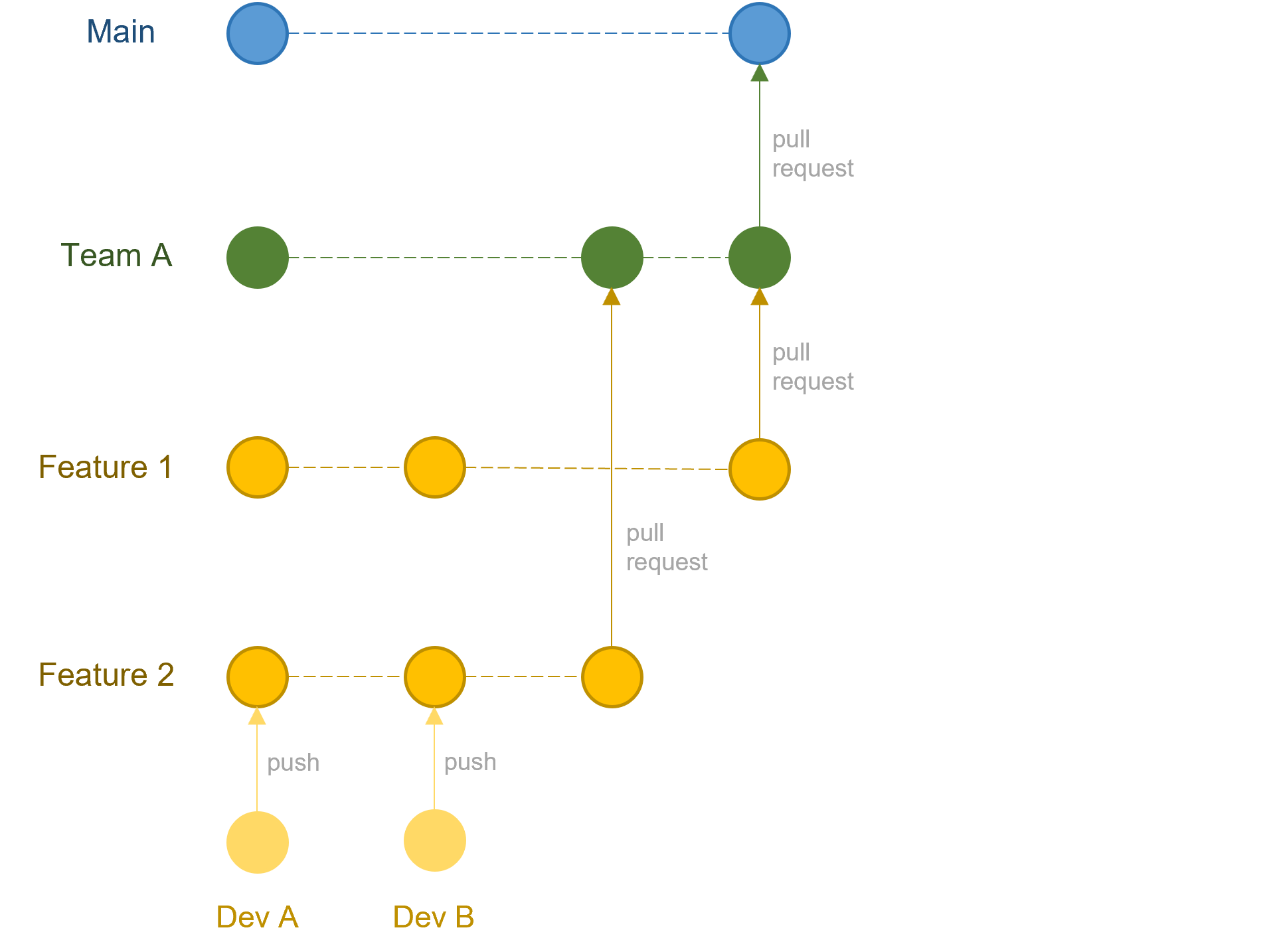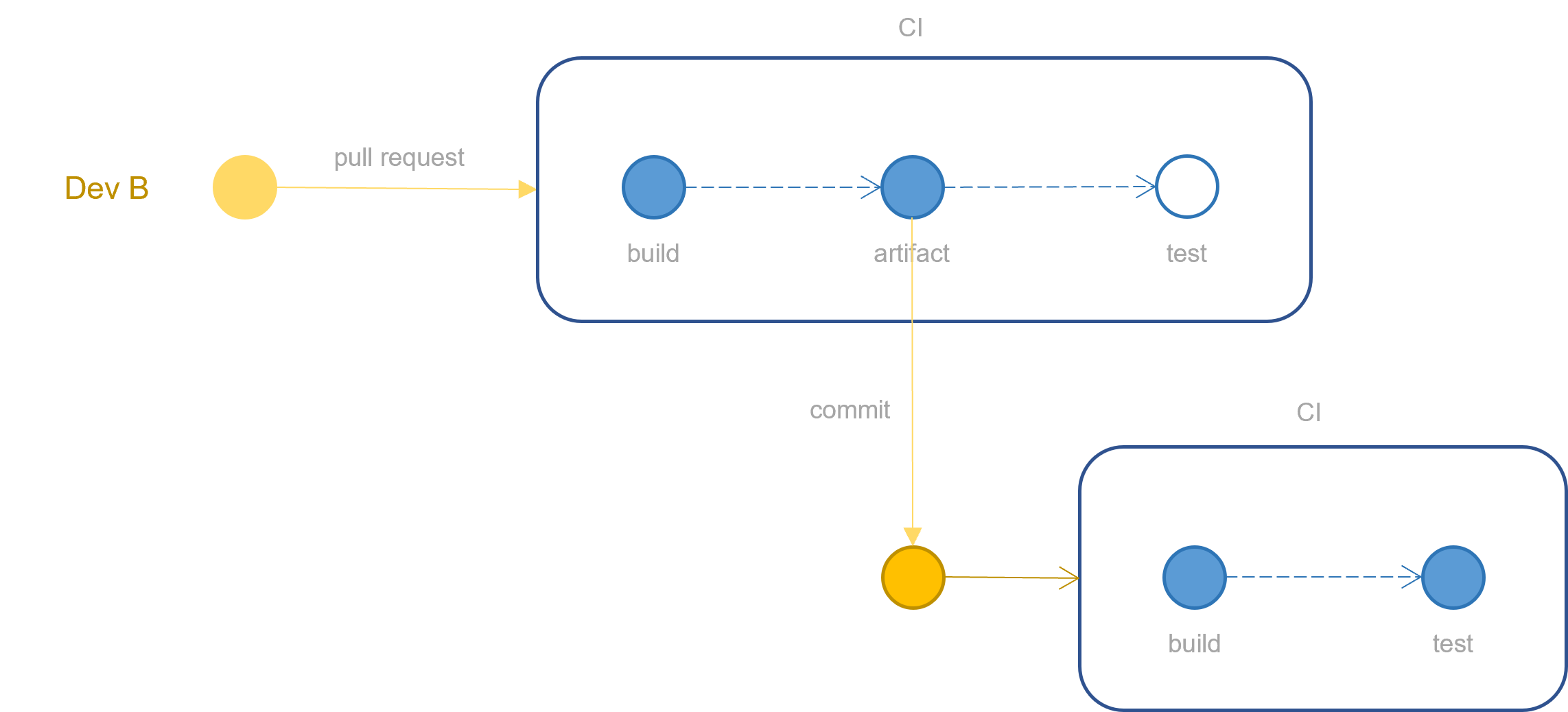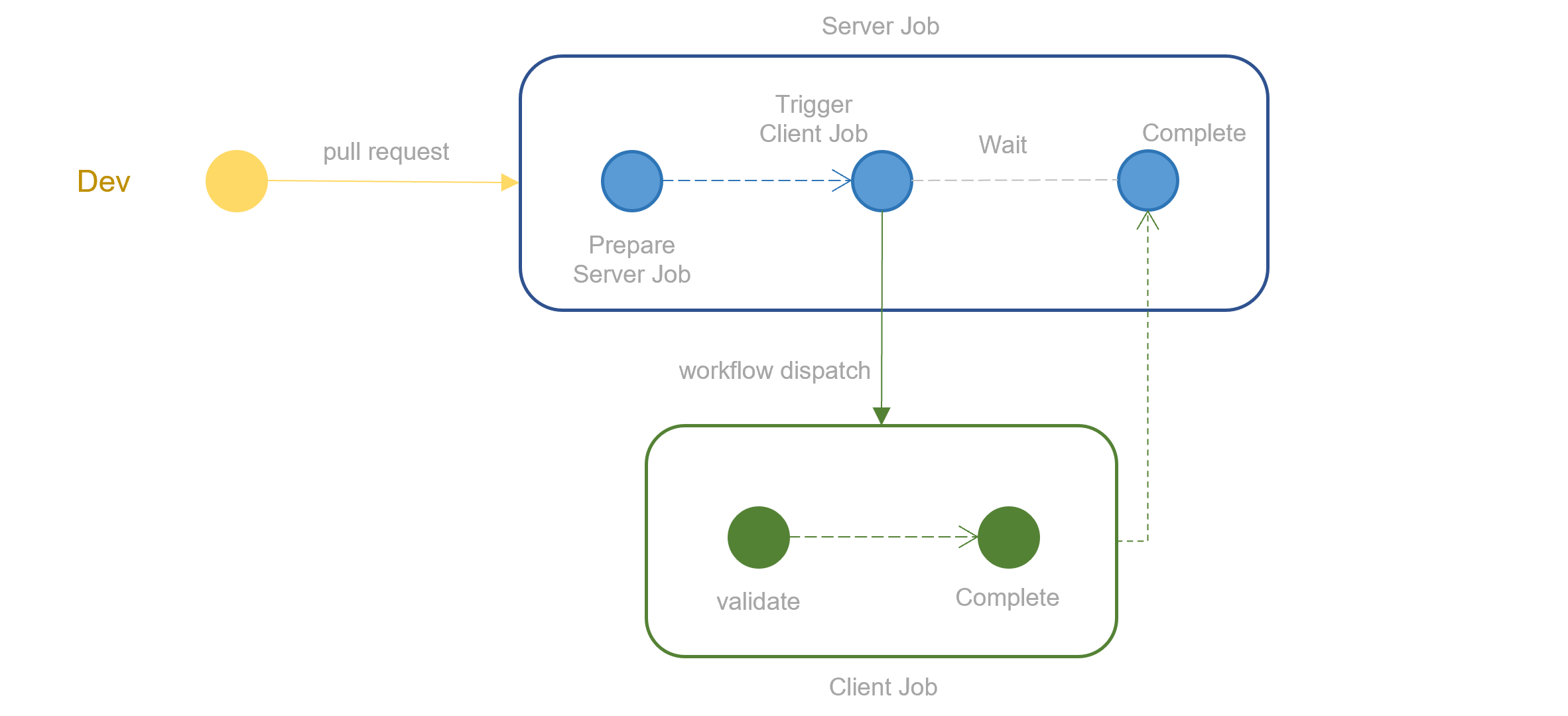Improving developer productivity with GitHub

In a large organization, a developer's productivity is important to ensure the best use of developer expertise and time in getting things done. Source control system and continuous integration (CI) workflows for feedback plays a key role in improving the productivity of developers.
The source code repository has evolved from just being a place to store code to a collaboration location for developers to ideate, discuss, and work on code.
GitHub is the #1 source control system for all software. It is used by a wide range of organizations, including companies like Adobe, Facebook, and Microsoft.
In this post, I will be sharing my experience with transitioning to GitHub and how it helps to improve developer productivity.
Challenges in current system
Lets look at in detail how the current system was setup and the challenges it posed to a growing developer community.
Centralized system
The source control management system being used was a centralized server-based repository. This was beneficial to the organization because it allowed developers to work on projects in a centralized location.
Perforce, Team Foundation Server are examples of centralized source control systems
Repository size and code churn
There would be a large code base that everyone worked on and made changes to the same code. Every time you had to make a change, you had to make sure you are latest version of the code, and if that code had conflicts, you had to resolve them. As the team grew, the code that every developer needed to synchronize with was growing larger and larger.
Continuous integration (CI)
To protect the code that goes-in the repository, there would be gates implemented that allow code that passes a certain criterion to be pushed to the repository.
In a centralized source code repository, once this gate is implemented, it restricts parallel validation of gates. The downside of this is that with the number of developers committing to the repository increases, the time to validate the gate increases. This was one important decision factor in the thought to move away from a centralized repository.
Branching and merging
Then there is the thought of supporting multiple branches that do not align with current project timelines and need to be developed in silos. With a centralized repository, it is costly to create a branch and keep it in sync with the project branch.
With all these points, the thought was put in to move to a decentralized repository.
GitHub for source control
The team decided to use GitHub as source control management system. This was a decision that was made to support the team's needs and to make the transition to a decentralized repository as easy as possible.
Some aspects that GitHub was able to provide us with are:
- Lightweight branching: We could easily switch between branches for developing different features.
- CI: GitHub Actions provided a easy way to setup CI and validate code before pushing to the repository.
- Code Reviews & pull requests: GitHub provides a way for developers to review & merge code via pull requests.
- Collaboration: Discussions on code improvements can be achieved via pull requests.
- Security: GitHub provide automatic security checks for code using Dependency Scanning and Code Quality.
- Documentation: GitHub Wiki can be used to document developer processes and scenarios.
Developer workflow
The critical piece of any source control system is how easy is it to implement a developer workflow. We had to take into consideration the existing process that was already in place, while trying to shift towards a more standardized workflow.
It was decided to work on feature branches while giving the team a central team branch for collaboration and validations.

The feature branches are lightweight and easy to create, merge or delete.
The developer is free to switch between branches depending on the task at hand, reducing complexities in managing shippable code.
Workflow setups
All the workflows for CI or Unit testing are setup on pull requests. The pull requests also include code reviews using GitHub's concept of CODEOWNERS.
CODEOWNERS is a file that is used to specify who can review a pull request. This can be specific developers or teams.
Every pull request then triggers a series of checks to ensure that the pull request is valid. Some of the checks are sequential, while some are conditionally triggered based on changed files. This allows for the optimal workflow for the developer while also providing a quick and easy way to validate the pull request.
# ci.yml
name: "Continuous Integration"
on:
pull_request:
branches: [ main, team ]
jobs:
ci:
name: CI job
runs-on: ubuntu-latest
steps:
- name: Checkout repository
uses: actions/checkout@v3
- name: Build
run: |
dotnet build Projects.sln
- name: Test
run: |
dotnet test Release Projects.sln
Workflow challenges
While most of the developer flow was easily mapped to GitHub, there are certain scenarios that needed extra attention.
CI Artifacts
Let's take the case when certain artifacts are generated at build time for the application, that also needs to be source controlled. The most common example of this could be an intermediate build artifact, required for subsequent flows.
Since all of the workflows are running on a pull request, the moment the artifact was generated and eventually part of source control, a second build was triggered. This was a problem for the developer.
To work around the problem, the work needed to be smart to detect a commit made by the CI system and automatically skip to the next step in workflow.
The below section explains two workflow paths for the developer.
Workflow 1
Developer has simple commits that trigger CI with build and test jobs. There is no artifact generated and the workflow is simple.

Workflow 2
Developer has commits that result in artifacts, where post the build artifact is generated, the artifact commit is pushed to the repository. The test job is then skipped.
The commit of artifacts results in a second workflow that triggers CI with build and test jobs.

The trick here is to detect whether the CI commits will be generated in first place in addition to skipping the test job. This prevents us relying always on the second job to do the test validation. There could be additional scenarios where the test validation will not be required, regardless of the artifact generation. Those should be correctly handled by appropriate conditional steps.
Example:
# ci.yml
- name: Build
run: |
dotnet build Projects.sln
- name: Generate & commit artifacts
if: ${{ generate_artifacts == true }}
run: |
dotnet build Package.sln
git add Output/*
git commit -m "Build artifacts"
git push
- name: Test
if: ${{ generate_artifacts == false }}
run: |
dotnet test Projects.sln
Client Server Validation
Another interesting scenario is when we need to verify application code by validating it in a client server environment. GitHub allows runners to run jobs in parallel, however once a job is finished it lets go of the runner, making it available for the next job. In the client server model, the server job is complete and now when client job starts validation, the server needs to have the application code up and running. If the runner for server job is handed over, the client job will be blocked.
To overcome this, the server job not needs to stay active and only complete when the client job has finished its validation. Also, the client job cannot start till server job is complete, so the server job when ready, triggers the client job and waits for its status.
This can be achieved by polling the client job or verification of client validation complete status in underlying data.

example:
# server.yml
name: "Application Validation"
on:
pull_request:
branches: [ main ]
jobs:
server_job:
name: Server job
runs-on: ubuntu-latest
steps:
- name: Prepare Server
uses: ./prepare_server
- name: Workflow Dispatch
uses: ./workflow-dispatch
with:
ref: ${{ ref }}
id: ${{ id }}
- name: Wait for client job
uses: ./wait-for-client-job
with:
ref: ${{ ref }}
id: ${{ id }}
# client.yml
name: "Client Validation"
on:
workflow_dispatch:
inputs:
id:
description: "Workflow Disptach ID"
required: true
jobs:
client_job:
name: Client Job
runs-on: ubuntu-latest
steps:
- name: Validate Application
uses: ./validate-application
- name: Save Results
uses: ./save-results
with:
id: ${{ inputs.id }}
Custom Actions
Not all steps in the workflow can be achieved with out of the box actions. There will be scenarios where the developer needs to implement custom actions.
The guidance followed for implementing custom actions is to keep one action with one responsibility.
Most of the new actions required taking certain inputs like configuration files (yml files) and related inputs. The action would then perform the operation and result in the output value. The language chosen for implementing the action was node, as it's easy to implement and easy to test with jest.
All the new actions were thoroughly unit tested with jest validating all possible combinations of inputs.
GitHub allows referencing local actions even from private repositories. The only requirement, clone the private repository and add it to the workspace. There after using them is straight forward with relative paths
Let's take the example where the action is defined in its own my-private-repo repo
# ./my-custom-action/action.yml
name: 'my-custom-action'
inputs:
config:
description: 'Some configuration file'
required: true
value:
description: 'Some value'
required: true
outputs:
result:
description: 'Result of the action'
runs:
using: node12
main: 'lib/index.js'
Action source code:
// ./my-custom-action/src/main.ts
import helper from './helper'
// This is the actual code that will implement logic or read inputs.
helper.doSomething();
The main.ts file is then compiled to Javascript using readily available tools like @vercel/ncc or webpack.
Then in the project repository, we can use the custom action
# workflow.yml
- name: Checkout private repo
uses: actions/checkout@v3
with:
repository: my-org/my-private-repo
token: ${{ PAT }} # Always use a PAT for cloning seperate private repos
path: ./private-repo
- name: My custom action
uses: ./private-repo/my-custom-action
with:
config: ./my-config.yml
value: 'abc'
# my-config.yml
abc:
value: '1'
pqr:
value: '2'
Important lesson is to keep the actions as small as possible, and not add complex login onto it, one can always chain multiple actions together (if required).
Managing Runners
Runners are machines used to setup for running jobs in GitHub, these can grow over time with the team size. Actively managing the runners is required to keep costs down, more on this topic in another post.
Training
Assume that not all your team members are familiar with GitHub. Developers may have a hard time understanding the workflow and how to use it.
Prepare a transition plan for your team, with trainings, hands on sessions, and a roadmap for the transition.
Be aware that the team will take time to adjust to the new normal and expect feedback to improve the current setup and flows.
Up next, GitHub for project management, Security and DevOps
Next step in the journey to transition to GitHub is to move project management, Security and DevOps to GitHub. None of this is easy to do, but it is possible.
Conclusions
GitHub is a good tool to enable the developers to collaborate, share code and get things done faster and easier.
With GitHub, the developers focus stays on code, while being able to discuss and make changes together.
The configuration of GitHub needs to be fine-tuned for your use cases and scenarios to be more productive.
Remember to
- Define your requirements
- Refine your workflows based on your requirements
- Test your implementation
- Rollout the new process
- Work on feedback and improvements
Nilesh Lanke and Chirag Vidani contributed to this post with me
Discussion
For any queries or feedback, please start a new discussion on GitHub Discussions or at Twitter @shubhan3009.
Cover image Credits
Photo by Nubelson Fernandes on Unsplash